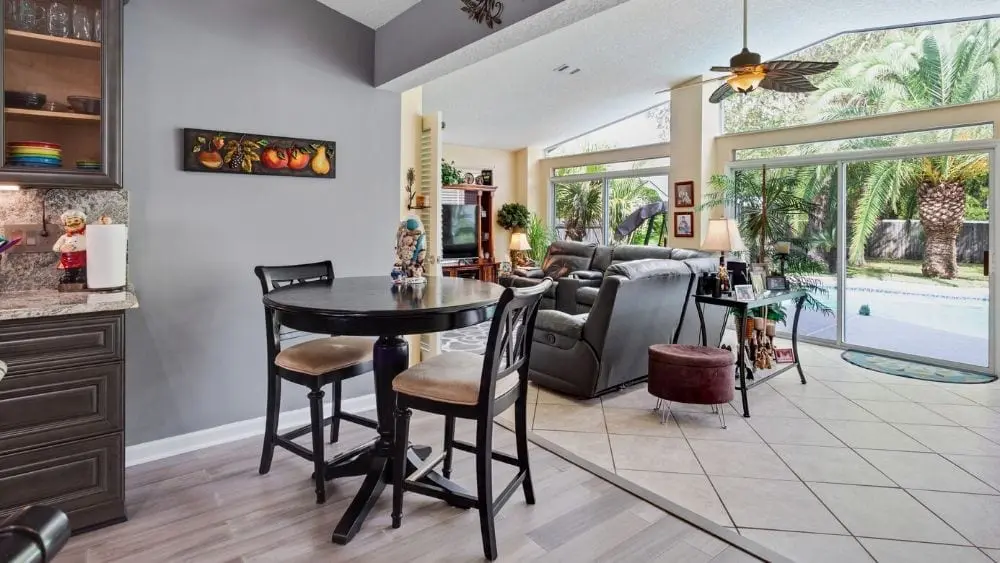
Current, comfy and clutter-free. That’s how most experts define the contemporary style of design. It’s the style most often confused with modern style, but it’s entirely different. Whereas modern refers to a specific period, usually somewhere between the early and mid-20th century, contemporary design is about what’s in style now.
As a result, it’s easy to pull off the contemporary style of design because pieces are rarely hard to find, which keeps the look attainable. You can go as high or low as you want, and mixing the two is entirely possible. Local home stores have displays and shelves stocked full of contemporary furnishings, many replicating the look of higher-end models.
It’s important to note that while contemporary design is of the moment, it’s not trendy. The latter means its popularity is destined to fade, but that’s not the case with contemporary design, at least not right away. A foundation of basics in neutral tones makes it easy to update this look over time, so it always feels current.
If you love the look of contemporary design, here’s how to decorate in that style, whether you’re starting fresh or simply looking to update your home.
Go Back to Basics
Simple but sophisticated without being fussy, the basis of contemporary design is a neutral color palette or a contrast of black and white. These days it sounds cliché to employ the overused term “pops of color,” but those words became popular in recent years precisely because of contemporary design. It practically begs for decor and accessories in interesting shades and shapes — but in a controlled manner that keeps them from overpowering the space.
The best way to keep the foundation basic is to stick to colors found in nature for the larger furniture pieces and the walls. However, that doesn’t necessarily mean a sea of creamy hues. Look for muted shades and layer shapes and patterns with furnishings and decor. For example, try pairing a slate blue sofa with pale walls and soft, natural flooring, then add a soft, textured throw and a few toss pillows for impact.
Furniture Lays the Foundation
When shopping for furniture, look for simple lines and gentle curves, not ornate detailing or special handiwork. Furniture should be measured to fit within a room — not overpower it — which means leaving some space bare rather than trying to fill every nook and cranny. Furniture covered in natural fabrics such as cotton, linen, wool, and leather set the stage perfectly. Look for those with exposed legs that leave airy space underneath. The more structural a piece is, the better. When it comes to seating, avoid mixing and matching colors, styles, or even fabrics. The more collective and unified your anchor pieces are, the more it will adhere to the contemporary style of design.
Keep Things Natural Underfoot
Continue to stick to natural fibers and soft shades, even when selecting floors and rugs. Floors should be bare and smooth, whether they’re wood, vinyl, or something else. If you opt for wood on floors or furniture, look for simple grains, such as maple. If a rug is covering a large swath of floor space, keep it neutral, especially if it has a pattern or design. Geometric shapes are synonymous with contemporary design, but it can also accommodate a floral pattern if the colors aren’t too bold. Botanical prints hint at nature and tend to have muted colors, hence why they work perfectly in contemporary design.
Use Lighting to Make a Statement
Perhaps because furniture and floors are kept neutral, lighting is one way to show off a bit of flair with contemporary design. The look itself calls for a layered approach to lighting. For example, try pairing recessed lights with floor, table, and perhaps even task lighting. Look for glass or metal pendants and chandeliers and always opt for dimmer switches, so you can use lighting to help set a mood. Turn to picture lights to help highlight a special piece of art or sculpture.
Leave Windows Bare or Minimally Dressed
Contemporary design prefers simple window treatments — or none at all. If privacy is an issue, opt for curtains or shades in natural fibers and colors and always choose something simple and retractable that will keep the room looking clean and fuss-free. Wood blinds, sheer or light-filtering curtains, and shades in natural fibers are most at home in contemporary design.
Accessorize Lightly
When selecting finishing touches for each room, err on the side of caution with just a few key pieces that will jumpstart conversations or show off your personality or travels. There’s no need to go minimal, just be selective to avoid clutter. It’s OK to introduce bright colors and patterns with pillows and decorative objects, so long as you don’t overdo it and nothing competes with each other. With a heavy emphasis on nature, consider houseplants and fresh flower arrangements part of your accessories’ roundup. Large blooms in dramatic containers are perfect. A fiddle leaf fig tree tucked inside a basket-style container is considered the “it” plant of contemporary design.
Simply Kitchens and Bathrooms
In these high-traffic spaces, go for natural materials and plenty of storage to keep surfaces clear. Mix high shine and matte pieces for a balanced look that’s elegant but understated. Waterfall edges and clean lines are key. Consider sideboards, cabinets, and other forms of storage that hide things away to maintain the clean order that’s so synonymous with contemporary design. Easy to update and universally admired, contemporary design is a safe, easy-to-achieve look that manages to exude both elegance and comfort.

Ana Connery is former content director of Parenting, Babytalk, Pregnancy Planner and Conceive magazines as well as parenting.com.
While editor in chief of Florida Travel & Life magazine from 2006-2009, she covered the state’s real estate and home design market as well as travel destinations.
She’s held senior editorial positions at some of the country’s most celebrated magazines, including Latina, Fitness and Cooking Light, where she oversaw the brand’s “FitHouse” show home.
Ana’s expertise is frequently sought after for appearances on “The Today Show,” “Good Morning America” and CNN. She has interviewed the country’s top experts in a variety of fields, including U.S. Secretary of Education Arne Duncan and First Lady Michelle Obama.
 Making the Most of a Video Tour of a Model Home
Making the Most of a Video Tour of a Model Home